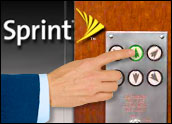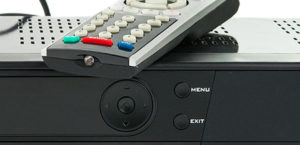
A quick look at the wireless industry over the last several years shows wave after wave of innovation and success. In fact, success has been bigger than anyone’s wildest dreams.
However, success does not come to all. Why do some companies, like AT&T and Verizon, seem to hit the ball out of the park, while Sprint Nextel and T-Mobile keep striking out? And what can they do about it?
My Pick of the Week is an interesting trend exemplified by two companies, 8 X 8 and RingCentral.
What’s the Problem?
Sprint Nextel has fewer customers and more spectrum per customer than both Verizon and AT&T, so it should also be growing rapidly right?
On the other hand, Sprint is on its third CEO over the last several years. Dan Hesse, who is Sprint’s current CEO, has made several important improvements with the service, but it is still struggling compared to the major competitors.
When Hesse joined Sprint several years ago, I expected a rapid recovery. That didn’t happen. So what’s the problem?
For one thing, the economy tanked. Did this cause Sprint to continue struggling? The economy crashing didn’t seem to hurt other companies like AT&T, Verizon, Apple and Google, as they rapidly grew in the wireless space. So I would say no. That was not the problem.
I have to give Hesse credit for repairing a broken Sprint. The company’s service has improved since he joined. In fact, the latest American Customer Satisfaction Index has Sprint in first place, ahead of AT&T, T-Mobile and Verizon Wireless.
Five years ago, Sprint’s service ranked last. Today, it is right up there with all the majors. That number surely means that all carriers are equal in the marketplace right? They aren’t.
So what is wrong with Sprint and T-Mobile? Why do they keep swinging and striking out?
Doesn’t Boldly Go
T-Mobile is still trying to recover from a self-inflicted late start joining the smartphone revolution. It missed the switch to 3G for several years. I waved the flag, but no one over there paid attention.
T-Mobile is on board now, but it is struggling to catch up to competitors, and it has not changed or updated its tired brand image in the marketplace either. Those are its obvious next steps.
So what’s Sprint’s excuse?
It has plenty of spectrum. Several years ago, it was one of the most advanced smartphone carriers in the industry. It led with smartphones and features. It was the first network to offer phones with cameras — and, in fact, the next generation of cameras as well. That was before other carriers finally jumped in.
So where did it fall off course?
I think Sprint’s problem is two parts: One is it’s a quiet and timid company without a bold strategy for growth. Two, customers have long memories, and Sprint is doing nothing to change that.
This is not new. These problems have nagged at Sprint for decades. Unfortunately, this seems to be the way Sprint is.
It has always been too quiet for its own good. I remember speaking at a Sprint retreat in Texas several years ago, and the executives all understood the problems, and they were ready to jump in and solve them.
It all sounded good at the roundtable, but by the time it came to pulling the trigger, all they shot were blanks. Being bold just isn’t Sprint’s style.
Over the last few years, I have noticed several occasions when CEO Hesse recommended acquisitions and deals, and the board simply said no.
Why was the board afraid to pull the trigger? Had it become too gun-shy from recent years of corporate failure, or has this just been a continual problem over decades?
Another problem is customers have long memories. Even after Sprint solves a problem, it takes a while for customers to catch on. So even though it solved the quality problem, customers will take several years to realize it.
This happened to Sprint in the 1990s as well, when it was a long-distance company. After a while, it solved its quality problems back then as well — yet it still took years for customers to realize it and for the company to recover.
Sprint eventually had to introduce an ad campaign with the pin drop on television commercials. Remember that?
Today’s problem comes in large part from the quality problems and customer care issues that are now solved, based on these recent surveys.
So if this problem is solved, Sprint should be performing like AT&T and Verizon. So what’s the problem now?
Sprint’s Solution
Sprint can either wait years for customers to figure it out once again, or it can help customers get it today.
My suggestion is simple. Update the brand. Yup. Refresh the brand. The solution is that simple. Yet for Sprint, it may also be that complex, because to tell you the truth, I am not sure Sprint really understands the power of this whole brand thing.
Every company has to continually refresh and modernize and expand its brand. Otherwise, the brand gets old and tired. Especially after a significant bout with problems like Sprint has dealt with over recent years.
Customers have to understand that the problems are behind them now.
Even AT&T updated its brand a few years ago, after SBC acquired the company and took the name. At the time, AT&T was the best-known brand in the business, but the valuable brand was old and tired.
I remember getting calls from SBC execs asking whether they should keep the SBC name or use AT&T after the acquisition. AT&T, of course, I said. That is the best-known and most valuable brand in the industry — but freshen it up.
So they youth-en-ized it. They turned AT&T into at&t and restructured the entire brand identity.
Today AT&T is once again one of the youngest and hippest brands in the business. Not as hip as, say, Cingular was, but that is another story.
Sprint needs to update its brand in a similar way in the mind of the customer. It needs a refreshed identity — a youth-en-ized identity. Tell the customer the problems no longer exist.
Sprint did send out an email on Monday pointing to this study. That’s good, but that’s not enough.
If it can do this one simple thing, I think it could turn the ship around in months, rather than waiting years for the marketplace to figure it out on it’s own.
So Sprint, what’s your next step?
One year from now your name could be hot and competitive and youthful and with-it, and your performance could match that of AT&T and Verizon. Or things can simply stay on the same slow track. Yawn.
This could be your comeback moment. Don’t waste it — use it.
Let’s see if Sprint realizes this is the core solution to the problem it has been wrestling with for years.
For better or worse, it is Sprint’s choice, after all., Time Warner and Cox, and others like Vonage and Skype — although quality, reliability and price differ from player to player.
I don’t use them, so I cannot address quality, but these companies sound like a good choice to consider in the newer and growing space for the small- and mid-sized business market.
I’ll be following this space and will keep you up-to-speed as it grows in importance.













































As a former Nextel, and then Sprint Nextel employee, your solution is partially right. One thing that Sprint did when merging with Nextel was assume two things: First that the Nextel Customers would be happy to be Sprint Customers, and second, Nextel was old and antiquated and should be dispatched as quickly as possible.
Nextel customers were loyal to the Nextel brand. Nextel offered the techies of that time a service, Direct Connect, that was not available anywhere else. Sure Verizon launched a walkie talkie, as did Sprint, however those were inferior products to the iDen product. I suspect they still are, but 3 and 4 G services have brought them much closer. Verison launched their service prior to the merger with Sprint, it was pretty much a failure, because of quality and the loyalty of Nextel customers. In fact, the few Nextel customers left, may leave Sprint when iDen goes dark. It is not about internet speeds, it was about business speeds. BlackBerry was available on the Nextel network, data speeds sucked, however, we found a way to migrate contacts to the new device. Nextel did not require contracts until a couple years before the merger, they intended to earn the business which made contracts unneccesary. They also did not subsidize phones to the extent as other carriers. When the i730 launched it was $300 for a flip phone that other carriers might give away. We sold out in a couple days. If a customer wanted a new phone, they could get it for the best price regardless of where they were in their contract. Was the service slow? Yes on the tech side, no on the customer service side. Nextel had a very flat managment tree, Tim Donahue was about 3 steps above me, a lowly store manager; after the merger Sprint installed umpteen new levels. That makes their customer service slow, and costs more. Dan Hesse has done a good job, but the levels below him are unwilling to change the culture to accept what he wants.
The first day post merger they changed the recording customers got calling a Nextel phone, intead of "please wait while the Nextel Subscriber is located" They replaced Nextel with Sprint, the out cry from customers forced them to change back. Nextel employees were trained on Sprint products, but Sprint employees either were not trained, or didn’t care about Nextel products. Now after all these years, most Nextel customers have given up hope that Sprint will ever do justice to the Nextel Brand, when it dies next year they probably will look at all available services.
I was glad to see the customer service rankings, when I worked for Nextel they always were neck and neck with Verizon as top dog, and it was important, not because we might get fired but rather as a pride issue.
I do wish Sprint well, I carry an iDen handset. I do wonder often what would happen if Motorola worked with another carrier to deploy iDen, if they could match the Nextel success. Throughout the merger it was said the new company would keep the best of each side, that didn’t happen and Sprint has suffered. Maybe they could learn by using the remaining Nextel people to develope the culture that could help them soar again… Probably not, that’s not the Sprint way.
I can’t help but think that you’re a marketing major of some sort. I didn’t see any mention of technological obsolescence. The problem with Sprint is that they bought Nextel, which operated on a completely outdated cellular technology. They have spent more money trying to rid themselves of the old iden nextel network, and less on investments, like the iphone.
They don’t want to make the mistake of merging with another company that doesn’t fit congruently with their current strategic plan of upgrading to LTE. Yes, Sprint needs to rebrand itself, but not with a useless merger.
You should give more concrete details on your rebranding strategy, rather than throwing out vague words; such as, "young" and "hip" as your replanning tools.
I believe AT&T and Verizon have a solid reputation at this point with devices that are in high demand and quality service. You have to go into further details of band wave length and other details that make these companies’ reception bar-none. But, that’s for another time.
Good luck on refining your article.